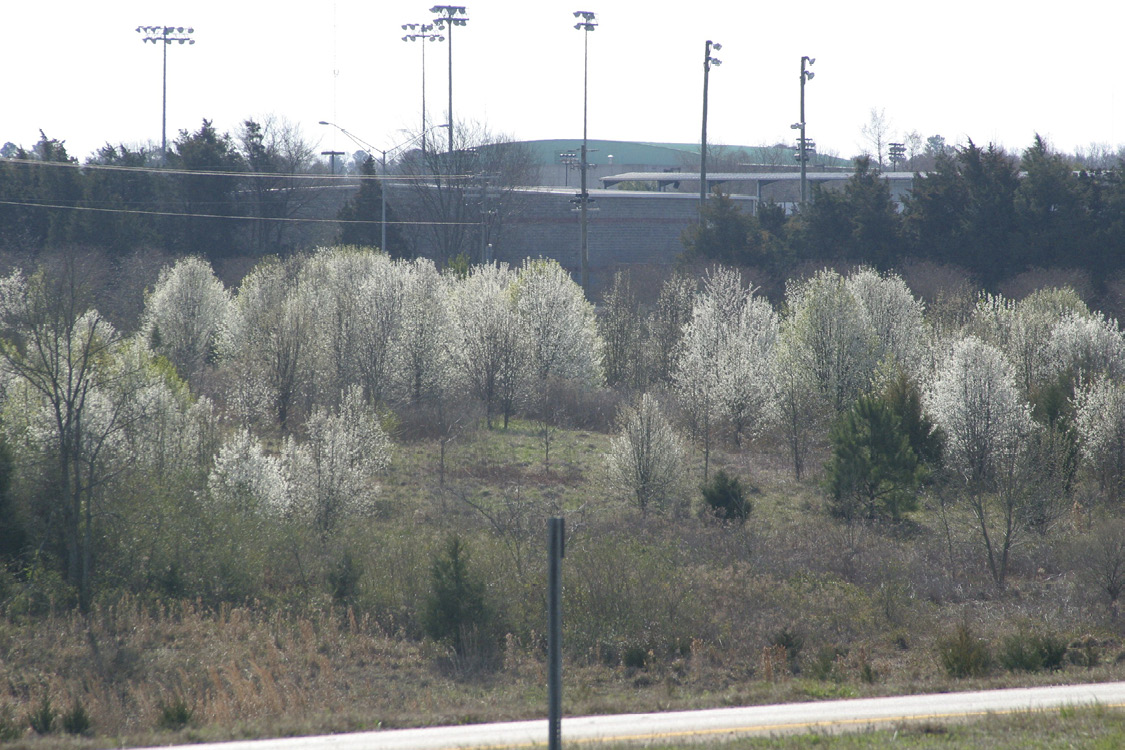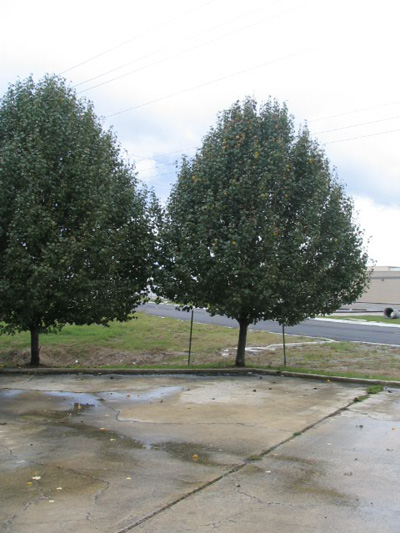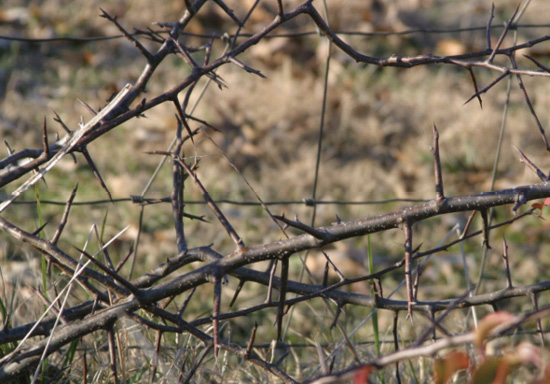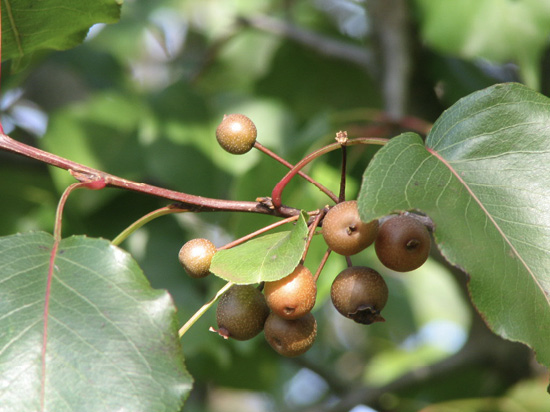Callery pear

Callery pear (Pyrus calleryana Decne.) is a small- to medium-sized tree in the Rosaceae Family (Figure 1). It is native to Asia. Cultivars such as ‘Bradford’ and others have been widely planted as ornamentals. It has also been used as rootstock for cultivated pears. Ornamental cultivars like ‘Bradford’ (Figure 2) are typically thornless, but seedlings from these thornless cultivars are not thornless. Some landowners may refer to escaped trees as ‘Bradford’ or wild pears. ‘Bradford’ was the first selected cultivar of callery pear, although other cultivars have been selected, and it is likely the most well-known cultivar. Pear cultivars are typically self-incompatible or have limited self-compatibility with regard to pollination and production of viable seed. Other cultivars must be introduced to cross pollinate different cultivars and produce viable seed. Once these trees escape from cultivation, as has happened in many states, the pollen incompatibility is mostly overcome by pollen produced by other escaped trees or pear trees used for fruit production. Thorns (Figure 3) on escaped trees are problematic for equipment and significantly increase eradication difficulty when reclaiming infested sites. Thorns on saplings can puncture vehicle, ATV, or tractor tires or cause injury to livestock. Brush and limbs of callery pear should be added to a burn pile and destroyed to prevent additional damage.


Regulations
Callery pear is not regulated as noxious in Mississippi or other states in the United States. Once established, it can be a difficult tree to eradicate due to numerous thorns, root suckering, and massive production of fruit, which are dispersed by birds and other vectors across Mississippi and much of the United States.
Description
Vegetative Growth
Mature trees reach around 50 feet in height with a spread of around 40 feet. Growth rate is relatively fast. Branches have smooth, greenish to brownish bark that darkens and thickens with age. The wood is hard and relatively dense. Cultivars like ‘Bradford’ have close, upright branches, which often result in splitting when exposed to strong winds, making it less desirable as an ornamental. Wild forms of callery pear have variable branching angles and may be less prone to splitting. The production of long, sharp thorns on branches is a problem for removal. Buds are about 0.5 inch long and densely woolly. Leaves are alternate, simple, petiolate, smooth, and 1.5 to 3 inches long. They are ovate to broadly ovate in shape, pointed at the apex, and have round, toothed margins. Leaves on young trees may be more elliptic ovate. Petioles are 1 to 1.5 inches long.
Flowering
Flowering occurs before leaves emerge, typically in March in Mississippi. Flowers are white, up to 1 inch in diameter, and have smooth inflorescences (corymbs). This feature is the primary appeal for callery pear as an ornamental. Flowers have five petals and sepals. Petals are nearly circular to oval and have smaller bases. The trees are deciduous. There are two or three styles and one pistil. Stamens are numerous. The fruit is a small, globular, fleshy pome, and it is about 0.5 inch across (Figure 4). It is dotted brown on the exterior, with an off-white, gritty-textured (stone cells) interior. A variety of birds and animals feed on the fruit and disperse the seed in droppings.

Seed Germination
Seeds require cold, moist stratification for 60 to 90 days prior to germination. That germination requirement is fulfilled, even while on the tree, in most of the south by winter’s end. Viable seeds are then ready for germination in warmer weather.
Habitat
Callery pear prefers open sites (such as rights-of-way), old fields (such as CRP land), and fence rows. Callery pear seems to do well on a wide range of soil types and moisture ranges. However, it is not considered a wetland species in Mississippi or other southern states.
Distribution
According to USDA’s Plants Database, callery pear currently occurs from New York to Illinois and south to Florida and Texas. However, it has escaped in states further west that are not currently on the USDA database map. It is likely adapted to areas in western and plains states that have suitable soils, moisture profiles, and temperatures. In Mississippi and many southern states, it occurs over much of the state in open habitats and is particularly troublesome near metropolitan areas, which are likely locations of landscaped callery pears.
Control Methods
Cultural
Shading may reduce seed production, but shade will not kill the plant.
Mechanical
Mowing and other mechanical methods have been used for callery pear, particularly when young. However, trees may persist under these conditions for many years. Hand removal may be practical for a small number of small trees but is not feasible for large infestations. Caution should be taken to avoid thorns during removal. Larger trees may require bulldozing for removal, but trees may still sucker from roots remaining in the soil. Mechanically removed vegetation should be destroyed by burning to prevent tire punctures or injury to livestock.
|
Herbicide |
Concentration per gallon |
Method |
Rate |
|---|---|---|---|
|
Aminocyclopyrachlor (Method) |
2 lb ae |
Basal |
10 to 20% solution + bark penetrator |
|
Foliar |
10–18 fl oz/A |
||
|
Frill or cut stump |
0.5 to 1 ml/incision or 5 to 10% solution |
References
Miller, J. H. 2003. Nonnative invasive plants of southern forests: A field guide for identification and control. Gen. Tech. Rep. SRS–62. Asheville, NC: U.S. Department of Agriculture, Forest Service, Southern Research Station.
Miller, J. H., E. B. Chambliss, & C. T. Bargeron. 2004. Invasive Plants of the Thirteen Southern States. Invasive.org: Invasive and Exotic Species of North America.
Southeast Exotic Pest Plant Council. 2003. Southeast Exotic Pest Plant Council Invasive Plant Manual.
Swearingen, J., K. Reshetiloff, B. Slattery, & S. Zwicker. 2002. Plant Invaders of Mid-Atlantic Natural Areas. National Park Service and U.S. Fish & Wildlife Service.
USDA, NRCS. 2019. The PLANTS Database. National Plant Data Team, Greensboro, NC 27401-4901 USA.
The information given here is for educational purposes only. References to commercial products, trade names, or suppliers are made with the understanding that no endorsement is implied and that no discrimination against other products or suppliers is intended.
Publication 3316 (POD-01-24)
By John Byrd, PhD, Extension/Research Professor, and Victor Maddox, PhD, Senior Research Associate, Plant and Soil Sciences.
The Mississippi State University Extension Service is working to ensure all web content is accessible to all users. If you need assistance accessing any of our content, please email the webteam or call 662-325-2262.


